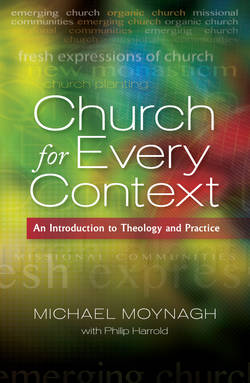Читать книгу Church for Every Context - Michael Moynagh - Страница 63
На сайте Литреса книга снята с продажи.
What are complexity theories?
ОглавлениеThere is not one complexity theory, but several (see Box).2 At the heart of them all is that change is not directed from the top but emerges from the system as a whole. It comes about in an unplanned way. It occurs through the amplification of novelty. A chance mutation in nature or a human invention rolls like a snow ball through the system, growing in influence as other elements or individuals in the system react positively to them. In response, agents ‘spontaneously’ combine to create new patterns of interaction. The emergence of these patterns is unpredictable because they have qualities that are genuinely new.3
Four types of complexity theory
Chaos theory shows how particular parameters, determined outside the system, cause the system’s behaviour to move toward a new state called an attractor.
Dissipative structure theory highlights the role of fluctuations, which are small variations in the movement of the entities comprising a system. The amplification of small fluctuations can cause the system to reorganize in an unexpected way.
Complex adaptive systems theory gives more attention to the interaction between agents. Differences between agents and in their interactions lead to spontaneous reorganization.
Complex responsive process theory sees novelty emerging primarily through human communication.
Source: Stacey, Griffin and Shaw, 2000, pp. 85–126; 186–9.
For some complexity theorists, a key concept is the ‘edge of chaos’. This is the border between order and disorder. When organizations are too orderly, there is little room for change and novelty. But push them over the boundary to chaos, and they fall apart. A region on the safe side of the boundary, close to but not lapsing into chaos, leaves enough freedom for novelty, for the innovation to be adopted by others, for the new eventually to replace an existing approach (the system reorganizes) and for this new approach to take root within the system.
Complexity theories seek to explain how systems self-organize in this way. From a theological perspective, it can be said that out of love the transcendent God passes the power of fertile self-organization to creation while remaining closely engaged through the Spirit. Theologians, such as Polkinghorne (1995) and Peacocke (1995), have offered conjectural models to describe the Spirit’s involvement. Nancey Murphy’s (1995) account is particularly helpful. She proposes that God acts at three levels. At the quantum level God activates each particle’s movement, while respecting the characteristics and limitations of the entities involved.
God is also active in events occurring at all levels of complexity above the quantum level but below free human action. Through the intentional manipulation of each element that constitutes an entity, God maintains the typical characteristics of that entity. So for example God maintains the distinctive features of a billiard ball; the behaviour of the ball in interaction with its environment emerges from the conduct of its constituent parts, whose characteristics God also maintains. Finally, God is active at the human level through his relationships with men and women. In these relationships, as in his interactions with the lower levels, God respects the traits and limitations of the other involved.
Through these levels of involvement, God acts on each piece of the created order to sustain the emergent processes integral to creation and the regular patterns described by ‘laws of nature’. Within the limits provided by the ‘natural rights’ of each constituent of creation, God sometimes governs these components in atypical ways and effects extraordinary behaviours. These exceptions make sense of prayer for events that defy the law-like behaviour of natural processes (Murphy, 1995, pp. 325–57). Thus there is ‘a divine self-investment in self-organizing processes’ (Gregersen, 2008, p. 92).4
